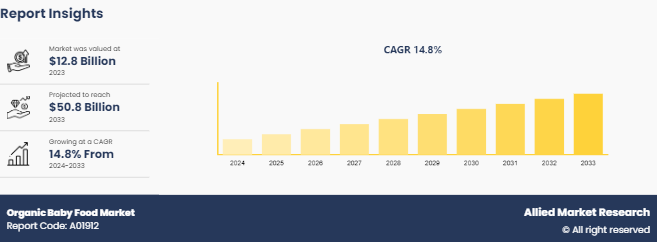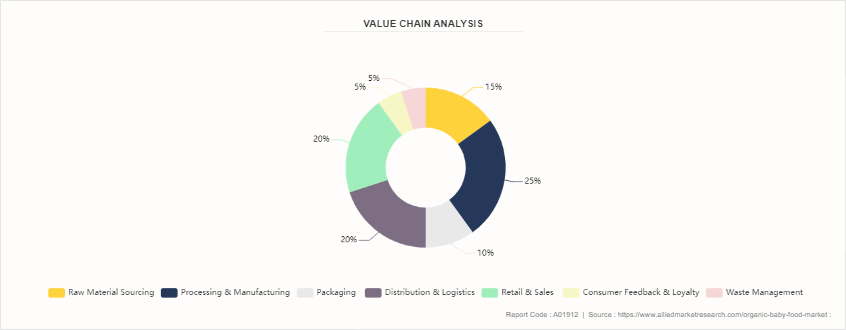Organic Baby Food Market Research, 2033
Market Introduction and Definition
The global organic baby food market was valued at $12.8 billion in 2023, and is projected to reach $50.8 billion by 2033, growing at a CAGR of 14.8% from 2024 to 2033. Organic baby food is gaining rapid traction among baby boomers across the globe owing to the surging awareness regarding the health benefits of organic food products and rise in health consciousness among consumers. Organic baby food products gain a steady share in the retail sector. The easy availability of organic baby food across the popular sales channels, such as supermarkets, hypermarkets, e-commerce, and departmental stores significantly fosters the market growth across the globe. Various government initiatives related to organic food production, increase in working women, and growth of nuclear families propel the organic baby food market growth. However, due to certain government regulations with respect to labeling of these organic baby food products and the premium price of the products hamper the growth of the organic baby food market.

Key Takeaways
The Organic Baby Food Industry study covers 20 countries. The research includes a segment analysis of each country in terms of value ($Million) for the projected period 2023-2033.
More than 1, 500 product literatures, industry releases, annual reports, and other such documents of baby food industry participants along with authentic industry journals, trade associations' releases, and government websites have been reviewed for generating high-value industry insights.
The study integrated high-quality data, professional opinions and analysis, and critical independent perspectives. The research approach is intended to provide a balanced view of global markets and to assist stakeholders in making educated decisions in order to achieve their most ambitious growth objectives.
Key Market Dynamics
Parents are becoming increasingly aware of the health benefits of organic food and are concerned about the potential risks associated with conventional food production methods, such as pesticide residues and synthetic additives. This heightened awareness is driving the demand for organic baby food, as parents seek safer and healthier options for their children. This trend is leading to higher sales of organic baby food products and encouraging manufacturers to expand their organic offerings to meet consumer demand, increasing the Organic Baby Food Market Size.
Growing disposable incomes, particularly in developing countries, are enabling more families to afford premium organic products. As economic conditions improve, consumers are more willing to spend on higher-priced organic baby foods, perceiving them as a better investment in their child's health. Increased disposable income contributes to market growth by broadening the customer base for organic baby food and allowing for greater market penetration., growing the Organic Baby Food Market Share
Organic baby food is typically more expensive than conventional baby food due to the higher costs associated with organic farming practices and certification processes. This price premium can be a barrier for price-sensitive consumers and limit market access. The higher cost of organic baby food can restrict market growth and limit its accessibility to a broader audience, especially in lower-income segments.
Organic baby food products may have limited availability in some regions, particularly in rural or less developed areas. Distribution challenges and limited shelf space in traditional retail outlets can also impact market reach.
Emerging markets, particularly in Asia-Pacific and Latin America, present significant growth opportunities for organic baby food. Increasing urbanization, rising health awareness, and growing middle-class populations in these regions are driving demand for organic products.
Value Chain of Organic Baby Food Market
The value chain of the organic baby food market involves several interconnected stages. It begins with raw material sourcing from certified organic farms, where ingredients are cultivated without synthetic pesticides or GMOs. These raw materials are then processed and manufactured into baby food products through methods that maintain organic integrity and ensure safety and quality. Packaging is done using eco-friendly materials that comply with organic certification standards and includes clear labeling. The products are distributed through various distribution channels such as supermarkets, specialty stores, and online platforms, with efficient logistics ensuring freshness. Retail and sales involve marketing and promotion to drive consumer purchases, with a focus on consumer education about the benefits of organic baby food. Finally, the consumer stage involves the purchase and consumption of the products, with feedback contributing to brand loyalty and market growth. Additionally, according to Organic Baby Food Market Forecast waste management practices are implemented to handle packaging and product waste responsibly, supporting the overall sustainability of the organic baby food value chain.

Market Segmentation
According to the?organic baby food market?analysis, the market is segmented on the basis of product, distribution channel, and region. On the basis of product, it is divided into prepared baby food, dried baby food, infant milk formula, and others. On the basis of distribution channel, it is classified into supermarkets/hypermarkets, pharmacies, department stores, e-commerce, and others. On the basis of region, the market is analyzed across North America, Europe, Asia-Pacific, and LAMEA.
Regional/Country Market Outlook
In the U.S., the growth is largely driven by increasing consumer awareness about health and safety concerns associated with conventional baby food. Parents are prioritizing organic options due to worries over pesticide residues, GMOs, and synthetic additives. Regulatory support from the USDA, including stringent certification standards and organic farming practices, bolsters consumer confidence and market expansion. The rise in disposable incomes also allows more families to invest in premium organic products, further propelling market growth.
In China, the organic baby market’s expansion is driven by a growing middle class with increasing disposable incomes and rising health consciousness. Consumers are increasingly seeking safe, high-quality food options for their children. The Chinese government supports the organic sector through various policies, including subsidies and incentives for organic farming and certification, which enhance market growth and development. As urbanization continues and more families shift towards premium organic products, the market is expected to experience robust growth.
Industry Trends
The demand for organic baby food is experiencing substantial growth as more parents prioritize health and safety in their children’s diets. This trend is driven by increasing consumer awareness about the potential risks associated with conventional food production methods, such as pesticide residues, genetically modified organisms (GMOs) , and artificial additives. Organic baby food is perceived as a safer and healthier alternative, which aligns with the growing trend towards natural and clean eating. This shift in consumer preferences is reflected in the expanding market for organic baby food, with many parents actively seeking products that offer transparency and reassurance about ingredient sourcing and processing. The EU Organic Action Plan aims to increase organic farming’s share of the EU agricultural land to 25% by 2030, which is expected to support continued growth in organic food categories, including baby food.
The organic baby food market is also witnessing a significant expansion in product variety, catering to the diverse needs and preferences of modern parents. Manufacturers are innovating and diversifying their product lines to include a range of options such as organic purees, cereals, snacks, and ready-to-eat meals. This trend is driven by the desire to offer convenient, nutritious, and age-appropriate foods for infants at different stages of development. The introduction of new flavors, superfoods, and nutrient-dense ingredients reflects a broader trend of enhancing the nutritional value and appeal of organic baby food products. This diversification not only meets consumer demand for variety but also helps to differentiate brands in a competitive market.
Competitive Landscape
The key players operating in the market include Abbott laboratories, Nestlé S.A., Hero Group, Amara Organics, Danone, Plum organics, The Hein celestial group, North Castle Partners, LLC. HiPP, and Baby Gourmet Foods Inc.
Recent Key Strategies and Developments
In April 2022, Gerber introduced an entirely organic plant-based line. A variety of organic pouches, snacks, and meals called Plant-tastic are manufactured solely from plant protein sources. The action follows Gerber's announcement in 2021 that it would work to produce more eco-friendly products. The Carbon Trust has certified Plant-tastic as carbon neutral.
In March 2021, Sun-Maid Growers of California acquired Plum Organics, a premium, organic baby food and kids snack brand, from Campbell Soup Company. Plum Organics offers a wide range of product portfolios for organic foods and snacks to meet the nutritional needs of babies, tots, and kids. Plum Organics' products are certified organic and non-GMO.
In January 2021, Hero Group acquired Baby Gourmet, a Canadian organic meal and snack brand for babies and toddlers. The acquisition included Slammers Snacks, a Baby Gourmet-owned organic children's snacks brand. The financial terms of the transaction were not disclosed.
Key Benefits For Stakeholders
- This report provides a quantitative analysis of the market segments, current trends, estimations, and dynamics of the organic baby food market analysis from 2024 to 2033 to identify the prevailing organic baby food market opportunities.
- The market research is offered along with information related to key drivers, restraints, and opportunities.
- Porter's five forces analysis highlights the potency of buyers and suppliers to enable stakeholders make profit-oriented business decisions and strengthen their supplier-buyer network.
- In-depth analysis of the organic baby food market segmentation assists to determine the prevailing market opportunities.
- Major countries in each region are mapped according to their revenue contribution to the global market.
- Market player positioning facilitates benchmarking and provides a clear understanding of the present position of the market players.
- The report includes the analysis of the regional as well as global organic baby food market trends, key players, market segments, application areas, and market growth strategies.
Organic Baby Food Market Report Highlights
| Aspects | Details |
| Market Size By 2033 | USD 50.8 Billion |
| Growth Rate | CAGR of 14.8% |
| Forecast period | 2024 - 2033 |
| Report Pages | 155 |
| By Product |
|
| By Distribution Channel |
|
| By Region |
|
| Key Market Players | The Hein celestial group, Baby Gourmet Foods Inc. , Nestlé S.A., Plum organics, HiPP, Hero Group, Abbott laboratories, Amara Organics, Danone, North Castle Partners, LLC. |
Analyst Review
Organic baby food market is estimated to depict a significant growth during the forecast period in Asia-Pacific, owing to rise in birth rates and growth in awareness with respect to the beneficial usage of organic baby food products. Moreover, these products contain negligible content of chemicals and pesticides, which supports the growth of organic baby food market.
Although this market is still at its nascent stage, it is expected to grow at a higher rate in the coming years due to less chemical content and health benefits associated with these products. Consumption of organic baby foods in the early stages of life improves the immune system among infants and kids. Prepared baby foods are available in the market with various flavors, such as mango, banana, and peach, providing taste and high nutritional value. Abbott nutrition offers infant formula under the Similac brand, which is gluten free and contains organic sugar and organic maltodextrin, which help to nurture the overall health of babies. All these companies are expanding their portfolio in the market, further supplementing the organic baby food market growth.
The global organic baby food market was valued at $12.8 billion in 2023, and is projected to reach $50.8 billion by 2033, growing at a CAGR of 14.8% from 2024 to 2033.
Consumers are demanding more information about ingredient sourcing, leading to more transparent labeling and ethical certifications.
The key players operating in the market include Abbott laboratories, Nestlé S.A., Hero Group, Amara Organics, Danone, Plum organics, The Hein celestial group, North Castle Partners, LLC. HiPP, and Baby Gourmet Foods Inc.
The leading application of the organic baby food market is infant nutrition.
The largest regional market for organic baby food is North America.
Loading Table Of Content...



